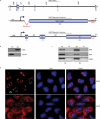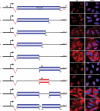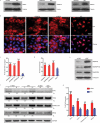Nuclear retention element recruits U1 snRNP components to restrain spliced lncRNAs in the nucleus
- PMID: 31107149
- PMCID: PMC6602561
- DOI: 10.1080/15476286.2019.1620061
Nuclear retention element recruits U1 snRNP components to restrain spliced lncRNAs in the nucleus
Abstract
In contrast to cytoplasmic localization of spliced mRNAs, many spliced lncRNAs are localized in the nucleus. To investigate the mechanism, we used lncRNA MEG3 as a reporter and mapped a potent nuclear retention element (NRE), deletion of this element led to striking export of MEG3 from the nucleus to the cytoplasm. Insertion of the NRE resulted in nuclear retention of spliced lncRNA as well as spliced mRNA. We further purified RNP assembled on the NRE in vitro and identified the proteins by mass spectrometry. Screen using siRNA revealed depletion of U1 snRNP components SNRPA, SNRNP70 or SNRPD2 caused significant cytoplasmic localization of MEG3 reporter transcripts. Co-knockdown these factors in HFF1 cells resulted in an increased cytoplasmic distribution of endogenous lncRNAs. Together, these data support a model that U1 snRNP components restrain spliced lncRNAs in the nucleus via the interaction with nuclear retention element.
Keywords: LncRNA localization; MEG3; U1 snRNP components; nuclear retention element.
Figures




Similar articles
-
U1 snRNP regulates chromatin retention of noncoding RNAs.Nature. 2020 Apr;580(7801):147-150. doi: 10.1038/s41586-020-2105-3. Epub 2020 Mar 11. Nature. 2020. PMID: 32238924 Free PMC article.
-
A 10S galectin-3-U1 snRNP complex assembles into active spliceosomes.Nucleic Acids Res. 2016 Jul 27;44(13):6391-7. doi: 10.1093/nar/gkw303. Epub 2016 Apr 21. Nucleic Acids Res. 2016. PMID: 27105840 Free PMC article.
-
The Sm core domain mediates targeting of U1 snRNP to subnuclear compartments involved in transcription and splicing.Exp Cell Res. 1999 Jun 15;249(2):189-98. doi: 10.1006/excr.1999.4468. Exp Cell Res. 1999. PMID: 10366418
-
A novel role of U1 snRNP: Splice site selection from a distance.Biochim Biophys Acta Gene Regul Mech. 2019 Jun;1862(6):634-642. doi: 10.1016/j.bbagrm.2019.04.004. Epub 2019 Apr 28. Biochim Biophys Acta Gene Regul Mech. 2019. PMID: 31042550 Free PMC article. Review.
-
U1 interference (U1i) for antiviral approaches.Adv Exp Med Biol. 2015;848:51-69. doi: 10.1007/978-1-4939-2432-5_3. Adv Exp Med Biol. 2015. PMID: 25757615 Review.
Cited by
-
Biology of the mRNA Splicing Machinery and Its Dysregulation in Cancer Providing Therapeutic Opportunities.Int J Mol Sci. 2021 May 12;22(10):5110. doi: 10.3390/ijms22105110. Int J Mol Sci. 2021. PMID: 34065983 Free PMC article. Review.
-
High-resolution mapping of function and protein binding in an RNA nuclear enrichment sequence.EMBO J. 2021 Jun 15;40(12):e106357. doi: 10.15252/embj.2020106357. Epub 2021 May 3. EMBO J. 2021. PMID: 33938020 Free PMC article.
-
Predictive and Prognostic Value of Non-Coding RNA in Breast Cancer.Cancers (Basel). 2022 Jun 15;14(12):2952. doi: 10.3390/cancers14122952. Cancers (Basel). 2022. PMID: 35740618 Free PMC article. Review.
-
Enhancing Gonadotrope Gene Expression Through Regulatory lncRNAs.Endocrinology. 2021 Aug 1;162(8):bqab116. doi: 10.1210/endocr/bqab116. Endocrinology. 2021. PMID: 34111287 Free PMC article. Review.
-
SNRPD2 Is a Novel Substrate for the Ubiquitin Ligase Activity of the Salmonella Type III Secretion Effector SlrP.Biology (Basel). 2022 Oct 17;11(10):1517. doi: 10.3390/biology11101517. Biology (Basel). 2022. PMID: 36290420 Free PMC article.
References
-
- Cheng H, Dufu K, Lee CS, et al. Human mRNA export machinery recruited to the 5ʹ end of mRNA. Cell. 2006;127:1389–1400. - PubMed
Publication types
MeSH terms
Substances
LinkOut - more resources
Full Text Sources
Other Literature Sources
Miscellaneous
